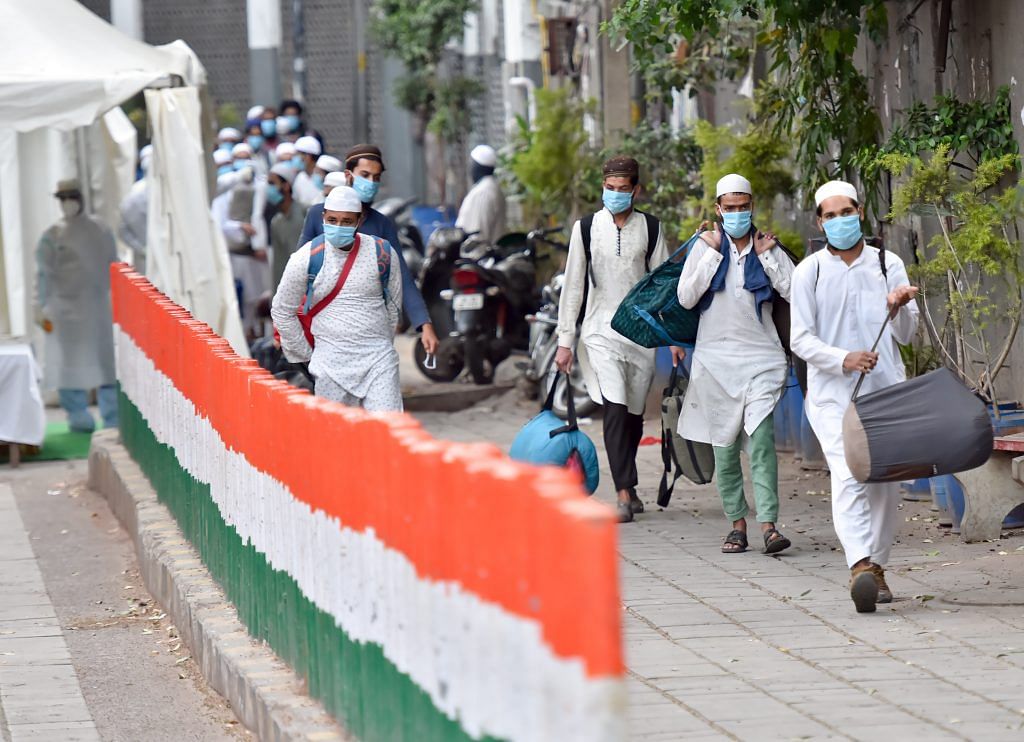As many as 1,750 out of 2,083 foreigners who participated in the mid-March Tablighi Jamaat congregation at Delhi’s Nizamuddin Markaz have been blacklisted and another 25,500 local Tablighis and their contacts quarantined, the Ministry of Home Affairs (MHA) said Monday, demonstrating the massive effort underway to contain the spike in India’s coronavirus cases.
Just last week, MHA had cancelled tourist visas of the 960 Tablighi Jamaat members who had participated in the Nizamuddin congregation. A look at their nationalities reveals that it was quite a global gathering.
Of the 250-odd Jamaat foreign activists found at the Markaz headquarters in Nizamuddin, there are 172 Indonesians, 36 Kyrgyz, 21 Bangladeshis, 12 Malaysians, seven Algerians, two Afghans, two US nationals, and one each from France, Belgium, Italy and Tunisia.
Another 247 foreign Jamaat members, who participated in the Nizamuddin congregation, have been found in Uttar Pradesh. Other states where these foreigners have been traced include Maharashtra(154), Tamil Nadu(133), Telangana(96), Haryana(86), West Bengal(70), Madhya Pradesh(59), Jharkhand(38), Andhra Pradesh(24), Uttarakhand(12), Odisha (7) and Rajasthan(5).
Also read: Tamil Nadu is worst-hit by Tablighi Jamaat event, but also seeing men admit participation
India’s visa policy to blame?
So how did so many foreign nationals gather in Nizamuddin in the heart of Delhi, and then, quickly spread across the country? How did they enter India in the first place?
Two things are slowly coming to light.
First. The tourist visas wrongfully used by several of these Jamaat members to enter the country were actually electronic-visas or e-visas.
Second. The e-visa policy was revamped in August 2019 to incorporate a meagre $25 fee for peak season travel between July-March, a $10 lean season fee between April-June, and a 5-year fee for $80. Incidentally, the ministry of external affairs (MEA) had warned its counterparts in the MHA to go slow, precisely to avoid such an eventuality.
But the Narendra Modi government had come to power with a thumping majority only a few months before, and the heady feeling had come to stay. The prime minister’s outreach to the world was substantively reinvigorated like never before. India’s unique diversity, its size and its population made it a natural leader in the region, Modi said. And now, he was its head again.
Also read: Tablighi Jamaat will have to change its ways in post-Covid world order
India’s outreach
Even in 2010 there had been a Tourist Visa on Arrival (TVOA) facility for five nations – Japan, Singapore, Finland, Luxembourg and New Zealand. In 2014, the Modi government merged TVOA with Electronic Travel Authorisation, creating the e-visa facility for 45 countries. By February 2019, the e-visa facility was expanded to 166 countries.
Foreign nationals applauded, because the new e-visa policy allowed them to stay in India for 90 days at a stretch (nationals from UK, US could stay for 180 days) and they could get their visa authorisation within 72 hours. But Indian diplomats worldwide took a deep breath.
The unwritten code in the ministry of external affairs over several decades has been to be wary of preachers and proselytisers. It’s a fine balance that diplomats maintain, allowing the practice of freedom of religion but not allowing conversions that may upset the delicate nature of a multi-cultural and multi-religious society like India.
Two sets of “tourists” have always put up the red flag in any Indian embassy abroad – Christian priests and Muslim preachers. Diplomats always have the power to summon people for personal interviews if they believe they need more information about visa applicants.
For example, if you demonstrated extreme religious views in your speech and/or in your dress – wearing shalwars above the ankle denote extreme Islamist beliefs – chances were you would be denied a visa to India. Cutting across both ideology and government, whether led by Atal Bihari Vajpayee or Manmohan Singh, diplomats followed the unwritten code of keeping messiahs out.
Also read: RSS says Tablighi Jamaat conduct not reflection on all Muslims, they’re aiding govt in fight
Modi returns the compliment
So, as Modi travelled the world after he returned as prime minister with a thumping majority – and the world returned the compliment – he made it his business to ease one of the worst headaches any potential traveller to India facces, that is, a visit to an Indian mission abroad to get a paper visa. The PM’s political direction was clear. Get the foreigner in.
Both the largely supportive Indian-origin community abroad – for whom the Overseas Citizens of India card was repackaged and even participation in elections considered – as well as foreign nationals were assiduously wooed.
The e-visa should have been the perfect instrument to allow the foreigner to experience Incredible India. Perhaps Home minister Amit Shah and his bureaucracy should have better heeded the warnings by MEA and kept a close watch on e-visa applicants, like the hundreds from the Tablighi Jamaat.
Views are personal.
